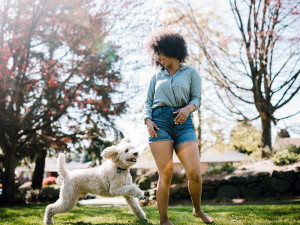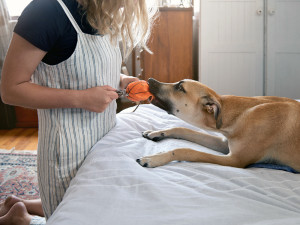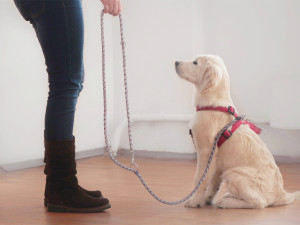Teaching a Dog to Sit Has Way More Steps Than Your Realize
In dog training, taking things one step at a time can make a world of difference.

share article

Your pet wants you to read our newsletter. (Then give them a treat.)
Telling a dog to “sit” is the most basic commandopens in a new tab most people can think of asking their pet to do, and yet many pet parents know how hard it can be to even make that work. As humans, we tend to conceptualize “sit” as one action, but sitting means nothing to a dog until we teach them it means something. Training them to the command means breaking something “simple” into even tinier composite parts and showing each one to the trainee so they can put it all together.
That sounds like a lot of work! On the bright side, your dog being unable to learn a basic command might have nothing to do with their intelligenceopens in a new tab level or desire to “dominateopens in a new tab” you — they just need to take training step by step.
Think from the pup’s POV.
Anything that we think of as a “behavioropens in a new tab,” like rolling over or asking a dog to sit and stay, is actually a summation of a great many tiny movements. These incremental movements add up into what we call “rolling over” or “giving a sit signal,” each of which is the sum of many parts.
Understanding this — that all actions are actually made up of many smaller ones — can elevate a moderately good dog trainer to a great one.
Here’s an example: a dog named Bruno was struggling with rolling over as a command, so all I asked him to do initially was to lie down and turn his head toward his tail. It helped Bruno to first lure his nose in the right direction with a piece of food, but in no time at all, Bruno was happy to offer the behavior on his own.
“Look at my tail for chicken? I can do that!”
Next, Bruno was asked to move his head a bit farther back, this time turning it toward his other side, enough that his top foreleg began to rise off the ground. More chicken was his reward. Step three lured his head even farther, until his body followed and completed the roll over in one smooth motion. Bruno had failed at the task before because his person wanted to reward him when the complete action was over, when he finally rolled all the way around. Bruno didn’t know what he was being asked to do and had no real motive to try.
Consider how we use praise with people.
Dog trainers see this problem on a daily basis — people who try to teach a dog to sit up or roll over, and end up throwing in the towel because they can’t get the dog to do what they want. This is one of those times when it would help if people were more anthropomorphicopens in a new tab, rather than less so as we’re often advised. We don’t wait to praise our children until they play Beethoven’s Fifth Symphony perfectly, do we? Yet, that’s common behavior with our dogs — we often expect them to do it right all the way through the first time. Anything less is categorized as a failure.
Look at your own behaviors to understand theirs.
We’re even less likely to think of our own actions as the summation of many tiny behaviors. Maddie was a dog who wouldn’t sit and also stay. After watching Maddie’s people give it a try it was clear what was going on. The mom of the family stood up, turned to face Maddie, and said “sit” and “stay.” As she said “stay,” she backed up about a half a step. In response, Maddie sat politely, but then leapt up as soon as she heard the stay signal. “See what I mean!” her person said, with no small amount of exasperationopens in a new tab in her voice. She was then asked to call Maddie to come.
She turned to face her dog and said, “Maddie, come!” Then she backed up exactly as she had when she said “stay.” Maddie was paying attention to one small component of the “stay” signal — the backward movement, which she had learned meant “come.”
Maddie kept giving it her best shot, in spite of the confusingopens in a new tab response of her humans. It’s a miracle they don’t bite us more often, truly.
Appreciate the complexity of a simple command.
The sagas of Bruno and Maddie illustrate two perspectives about behavior. One is that a “simple” behavior like asking your dog to sit usually consists of several different sounds and movements, any one of which could be relevant to your dog. We may think that saying “sit” is a singular event, but to an observant dog there’s a lot more going on. And they’re all pretty observant! You may be concentrating on the word, but as you say it, your hands, head, and body are all probably moving in consistent ways, even if you’re not aware of it.
Try having someone watch you ask your dog to sit, and then ask how many different movements made up that “simple” signal. Usually, there are at least six or eight movements and one spoken word, any of which could act as the relevant cue to the dog. One time, as a trainer asked for a dog sit, she nodded her head ever so slightly. Until her dog saw her nod her head, he would not sit. Once she did, he’d sit instantly. The dog was focusing on the nod, and the human was focusing on the word she was saying. If you could’ve asked the dog to describe the signal for “sit,” the dog probably would’ve said, “Why, the head nod, of course!”
The general principle of dividing an action up into steps is old news for many trainers, but we can profit from revisiting its importance. Even those of us who are long familiar with what’s called “shaping,” or the process of reinforcing incremental improvements in behavior, can benefit by remembering that it relates to everything that we and our dogs do.
Understanding that any behavior can be divided up into smaller parts is the guiding principle taught to all students of animal behavior. Step-by-step, brick by brick, the foundation of any behavior is built upon little things that add up to bigger ones. The better you are at deconstructing it, the better a trainer you’ll be.

Patricia McConnell, PhD
Patricia McConnell, PhD, is an animal behaviorist and ethologist and an adjunct associate professor in zoology at the University of Wisconsin, Madison, as well as the author of numerous books on behavior and training.
Related articles
![illustration of multi-colored dogs]() opens in a new tab
opens in a new tabIs Your Dog Tricky to Train? Here’s Why You Shouldn’t Feel Guilty
It’s important to remember that dogs are individuals, so training isn’t one-size-fits-all.
![A blonde woman wearing a black t-shirt and striped overalls playing tug with her tan dog using an orange basketball squeaky toy]() opens in a new tab
opens in a new tabPlaying Tug With Your Dog Is Good Exercise For Both Of You
Basics of the tug game and how to troubleshoot common problems.
![Two dogs acting rowdy at the lake while a person tries to calm them down]() opens in a new tab
opens in a new tabMy Dog Is Misbehaving. What Should I Do?
Don’t blame the dog — instead, figure out how to help them succeed.
![a dog held on a leash sits calmly]() opens in a new tab
opens in a new tabDogs Who Are Easy to Train: Top 10 Easiest Dogs to Train
Spoiler: It’s not about the breed. But these pups are pretty brainy.






